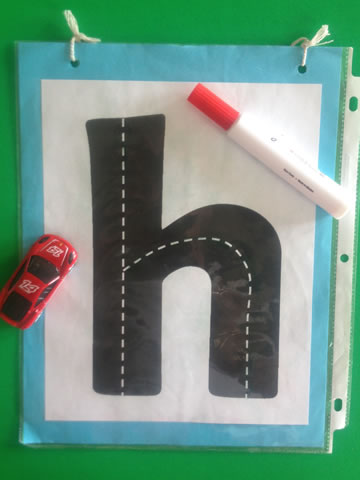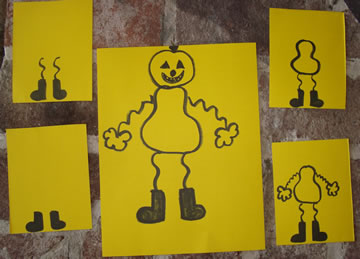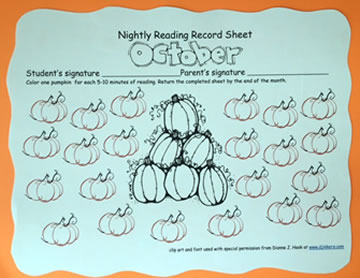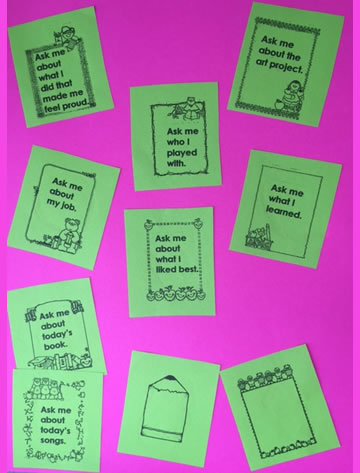October 2015
SINGING AND DANCING
LETTERS AND SOUNDS
SINGING AND DANCING
Music and movement are the most convenient ways to learn anything. These songs will give children the opportunity to release wiggles, develop alphabet knowledge, and have fun.
•According to reading research expert Maryanne Wolf, start singing alphabet songs with young children because songs put the letters in the brain and act like a “place holder” for when they are introduced formally.
Who Let the Letters Out? (“Who Let the Dogs Out?”)
Who let the A out?
/a/ /a/ /a/ /a/ /a/
Who let the B out? etc.
The Alphabet in My Mouth(“He’s Got the Whole World in His Hands”)
I’ve got the whole alphabet in my mouth.
I’ve got the whole alphabet in my mouth.
I’ve got the whole alphabet in my mouth,
And I can read.
I’ve got A - /a/ /a/ - in my mouth.
I’ve got B - /b/ /b/ - in my mouth.
I’ve got C - /c/ /c/ - in my mouth,
And I can read…
Happy Birthday Letters
Yo, A, it’s your birthday.
Let’s all read
Like your birthday.
/a/ /a/ /a/ /a/ /a/ /a/
/a/ /a/ /a/ /a/ /a/ /a/
Yo, B…
Phon-ercise
Put your hands in the air and say the letter. Touch your shoulders and make the letter sound. Touch the ground and name a word that begins
with that sound.
A - /a/ - alligator
B - /b/ - ball
C - /c/ - cat…
Backwards Alphabet
Sing the traditional “Alphabet Song” slowly as you point to the letters on your alphabet. Can you sing it backwards?
End the backwards version by singing, “Now I’ve said my Z Y X’s. Bet that’s not what you expected!”
Hint! “I’ve Been Working on the Railroad ,” “100 Bottles of Pop on the Wall,” “The House of the Rising Sun,” “Amazing Grace“, “The Brady Bunch,” and many other familiar tunes can be used to sing the alphabet!
Mmm! Mmm! Good(“Campbell’s Soup Song”)
Insert these sounds into this familiar song:
/g/ /g/ /g/
/g/ /g/ /g/
That’s what “G” says,
/g/ /g/ /g/
What’s This Letter? (Tune: “Bingo”)
Oh, what’s this letter, do you know?
What letter can this be – o
/a/ /a/ /a/ It’s an A (shout)
/a/ /a/ /a/ it’s an A!
/a/ /a/ /a/ It’s an A!
That is it’s name-o.
Sing and Sign (“Where Is Thumbkin?” – Children repeat each line.)
Where is A? (Hands behind back.)
Here I am. (Make sign for “a.”)
What do you say, A?
/a/, /a/, /a/.
Continue using other letters and making the manual signs.
VISUAL – AUDITORY HOOKS
Help children connect sounds with the visual symbols with these strategies.
Stop, Touch, Freeze!
As you sing alphabet songs randomly stop on different letters. The children must walk around the room, find the letter, touch it, and freeze.
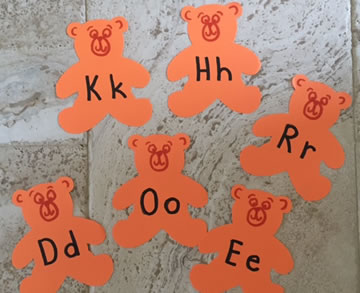 Letter Bears
Letter Bears
Cut out 26 paper bears and write a different letter on each one. Shuffle up the bears and then sing this song to the tune of “Twinkle, Twinkle, Little Star” as you show the letter.
D bear, D bear, what do you see?
I see M bear looking at me.
M bear, M bear, what do you see?
I see Y bear….
•Use seasonal cutouts for a similar activity.
Click to download a printable for Letter Bears.
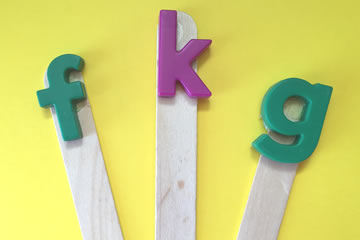 Letter Pops
Letter Pops
Glue magnetic letters to jumbo craft sticks and pass these out to the children. As you sing songs have them hold up their letter.
•Let them walk around the room and match their up to classroom print.
•Let them find like letters in books.
Highway Letters
Highway letters can be downloaded free from makinglearningfun.com.
Insert letters in clear sheet protectors with the uppercase letter on one side and the lowercase letter on the reverse side. Children can drive over these with toy cars or they can roll play doll and place it on top of the letters.
•Let them trace letters with a dry erase marker and then erase.
TELL ME A STORY
As you repeat favorite stories, invite the children to join in, chant favorite lines, and recall events.
Scat the Cat
Once there was a little black cat. He was a magic cat because he could change his colors (snap fingers) just like that. All he had to say was:
CHORUS: I’m Scat the Cat.
I’m sassy and fat. (Children join in on the chorus.)
And I can change my colors (snap) just like that!
One day Scat decided he was tired of being black. He wanted to be a new color so he said:
CHORUS.
And he changed blue! Scat went down to the pond to look at himself in the water. Unfortunately, he fell in and he couldn’t swim. Timmy Turtle came along and helped Scat get back on shore. Scat decided he didn’t want to be blue any more, so he said:
CHORUS.
And he changed red. He went walking down the street and everybody started laughing at him. “Whoever heard of a red cat!” they said. Scat decided he didn’t want to be red any more, so he said:
CHORUS. 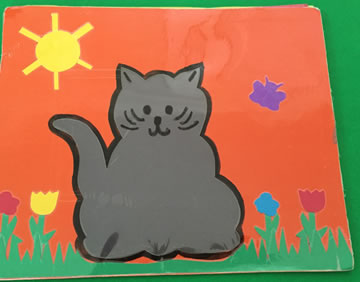
And he changed yellow. Scat went walking in the woods and who did he run into but his cousin Leo the lion. “Grrrrrr!” roared Leo. “I’m the only cat who can be yellow.” Scat decided he better not be yellow any more and he quickly said:
CHORUS.
Scat wanted to play with his brothers and sisters in the grass. He tried to play with them, but he was green like the grass and they couldn’t see him. Scat decided he didn’t want to be blue, or red, or yellow, or green, so he said:
CHORUS.
Scat knew that being himself was the best thing to be. And do you know what? Being yourself is the best thing you can be, too. Because there’s nobody else exactly like you. And I like you just the way you are!
•Make felt cats of the different colors and place on the flannel board as you tell the story.
•Pass out stick puppets with black, blue, red, yellow, and green cats and ask children to hold them up at the appropriate place in the story.
Click to download Scat the Cat.
PUMPKIN HOUSE
You will need orange paper and a pair of scissors to “cut and tell” this story. Begin with the paper and scissors in your lap. As you tell the story, cut out the different parts with the scissors as indicated. At end of the story, the children will be delighted with the pumpkin house!
Hint! You can also tear out the paper with your fingers.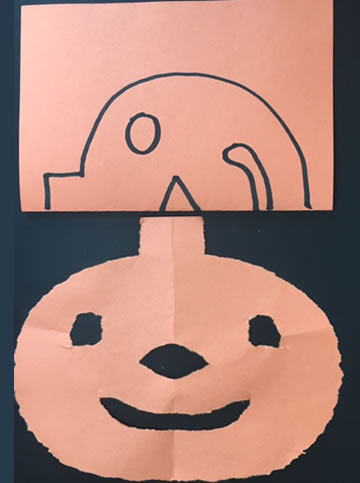
Once there was a little old lady who lived in a funny orange house near name of your school.
Her house was shaped like half a circle with the chimney at the bottom.
This little lady had a cat named child’s name in your room. This cat had a long, curved tail, so the old lady had a special door cut just for the cat’s tail.
The little lady always wore a pointed hat. She had a special door built for herself, too, so her hat would not fall off every time she went in and out the door.
The little lady had two pet birds. Their names were child’s name and child’s name. She had a window cut just for them so they could fly in and out and in
and out.
It was getting close to Halloween, so all the children in teacher’s name classroom went to her house and knocked on her door. The little lady came to the door and said, “Close your eyes.” SURPRISE! It’s a jack-o-lantern!
Click here for more Dr. Jean videos. Use this link to download directions.
PUMPKIN MAN
Pumpkin Man Tell and Draw Story
You will need a large sheet of paper and a marker to tell this story. Tell the children that you will need their help and teach them the movements below:
“Knock” – pretend to knock on a door
“Rock” – move body back and forth
“Spin” – twirl hands around each other
“Come In” – make motion with hand
Draw the body parts on the paper as you come to them in the story.
Once there was a little old lady who would just sit all day and rock and spin and wait for somebody to come in.
One day as she rocked and spin she heard a knock at the door. “Come in,”
she called.
In came two big, black boots. (Draw boots on the board.) “I can’t talk to you big, black boots,” said the little old lady.
So she just sat there and rock and spin until she heard a knock at the door. “Come in,” she called.
And in came two bony legs. (Draw two skinny legs coming out of the boots.) “I can’t talk to two bony legs,” said the little old lady.
So she just sat there and rock and spin until she heard a knock at the door.
“Come in,” she called.
And in came a funny body. (Draw a pear shaped body on top of the legs.) “I can’t talk to a funny body,” said the little old lady.
So she just sat there and rock and spin until she heard a knock at the door. “Come in,” she called.
And in came two wiggly arms. (Draw wiggly arms coming off the body.) “I can’t talk to wiggly arms,” said the little old lady.
So she just sat there and rock and spin until she heard a knock at the door. “Come in,” she called.
And in came two big hands. (Draw hands at the end of the arms.) “I can’t talk to two big hands,” said the little old lady.
So she just sat there and rock and spin until she heard a knock at the door. “Come in,” she called.
And in came a big pumpkin head. (Draw a pumpkin head on the figure.)
“Well, I can talk to a pumpkin man,” said the little old lady. And she did!
End by singing “Do You Know the Pumpkin Man?” to the tune of “Do You Know the Muffin Man?”
FAMILY CONNECTIONS
In Amada Ripley’s book THE SMARTEST KIDS IN THE WORLD, one of the most interesting findings was that what parents did at home mattered significantly. Parents showed their children they valued education by asking about school, what they learned, what they liked, etc. Parents who modeled reading also had a positive impact.
Here are a few tips to encourage parents to communicate with their children daily.
Journal – Make daily journals for students by putting white paper in a pocket folder. At the end of each day students draw what they learned and dictate or write a sentence to go with their drawing. The journal goes home each evening so children can discuss what they did at school with their parents. The parents sign the journal, write comments or compliments, and return it the following day.
Reading Calendar – Send home a reading calendar at the beginning of each month. Parents and children can color in an object for each 5-10 minutes of reading. Make sure calendars are returned at the end of each month. (You can download these on my website.)
Brain Tickets – Run off brain tickets similar to the ones shown. To earn a brain ticket children need to tell the teacher one new thing they learned at the end of each day. Tell the parents that their job is to ask their child what she learned to earn the ticket.
Here is a link to download Brain Tickets.
